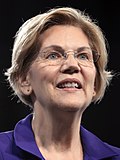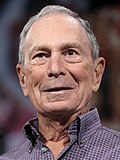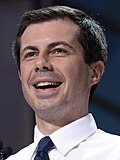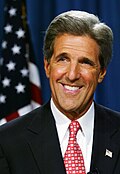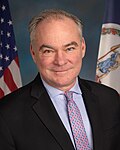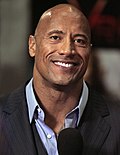Top Qs
Timeline
Chat
Perspective
2020 Democratic Party presidential primaries
Selection of the Democratic Party nominee From Wikipedia, the free encyclopedia
Remove ads
Presidential primaries and caucuses were organized by the Democratic Party to select delegates to the 2020 Democratic National Convention to determine the party's nominee for president in the 2020 election. The primaries and caucuses took place in all 50 U.S. states, in the District of Columbia, in five U.S. territories, and through Democrats Abroad. They occurred between February 3 and August 11, 2020.
Former vice president Joe Biden led in the polls throughout most of 2019. The 2020 Iowa Democratic presidential caucuses were marred by technical problems; certified results of the caucus eventually showed Mayor Pete Buttigieg winning the most delegates, while Senator Bernie Sanders won the popular vote in the state. Sanders then won New Hampshire and Nevada. Biden, whose campaign fortunes had suffered from losses in Iowa, New Hampshire and Nevada, made a comeback by overwhelmingly winning the South Carolina primary. After Biden won South Carolina, and one day before the Super Tuesday primaries, several candidates dropped out of the race and endorsed Biden. Biden then won 10 out of 15 contests on Super Tuesday.
On April 8, after Sanders withdrew from the race, Biden became the presumptive Democratic presidential nominee. Biden and his running mate, U.S. senator Kamala Harris of California, were nominated for president and vice president by delegates at the Democratic National Convention. Biden and Harris won the presidency and vice presidency in the general election on November 3, defeating incumbent President Donald Trump and incumbent Vice President Mike Pence.
Remove ads
Overview
Summarize
Perspective
A total of 29 major candidates declared their 2020 Democratic presidential candidacies. With the exception of a brief period in October 2019 when Senator Elizabeth Warren experienced a surge in support, former vice president Joe Biden led in the polls throughout 2019.[3] Eighteen of the 29 declared candidates withdrew before the first primary contest. The first primary was marred by controversy, as technical issues with vote reporting resulted in a three-day delay in vote counting in the Iowa caucuses. The certified results of the caucuses showed Mayor Pete Buttigieg winning the most delegates, while Senator Bernie Sanders won the popular vote in the state. Sanders then won the New Hampshire primary in a narrow victory over Buttigieg before comfortably winning the Nevada caucus, solidifying his status as the front-runner for the nomination.[4][5] Sanders received significant support from Asian, Hispanic,[6] and young voters.[7]
Biden, whose campaign fortunes had suffered from losses in Iowa, New Hampshire and Nevada, made a comeback by overwhelmingly winning the South Carolina primary. Biden was helped by strong support from African American voters, an endorsement from South Carolina U.S. Representative Jim Clyburn, and Democratic establishment concerns about nominating Sanders.[8] After Biden won South Carolina, and one day before the Super Tuesday primaries, several candidates dropped out of the race and endorsed Biden; before that time, polling saw Sanders leading with a plurality in most Super Tuesday states.[9] Biden then won 10 out of 15 contests on Super Tuesday, beating back challenges from Sanders, Warren, and former New York City Mayor Michael Bloomberg and solidifying his lead.[9] As the primaries proceeded, they were overshadowed by the COVID-19 pandemic, which was declared to be a global pandemic on March 11, 2020.[10] Between March 19 and April 7, most states in the country issued stay-at-home orders, and the overwhelming majority of campaign activity was suspended.
On April 8, 2020, Biden became the presumptive Democratic nominee after Sanders (the only other candidate remaining) withdrew from the race.[11] In early June, Biden passed the threshold of 1,991 delegates to win the nomination.[12][13] Seven candidates received pledged delegates: Biden, Sanders, Warren, Bloomberg, Buttigieg, Senator Amy Klobuchar and U.S. Representative Tulsi Gabbard.[14] On August 11, Biden announced that former presidential candidate Senator Kamala Harris would be his running mate.[15]
Biden and Harris were nominated for president and vice president by delegates at the Democratic National Convention on August 18 and 19.[16][17] Biden and Harris won the presidency and vice presidency in the general election on November 3, defeating the Republican ticket of President Donald Trump and Vice President Mike Pence.
Remove ads
Background
Summarize
Perspective
After Hillary Clinton's loss in the previous election, many felt the Democratic Party lacked a clear leading figure.[18] Divisions remained in the party following the 2016 primaries, which pitted Clinton against Bernie Sanders.[19][20] Between the 2016 election and the 2018 midterm elections, Senate Democrats generally shifted to the political left in relation to college tuition, healthcare, and immigration.[21][22] The 2018 elections saw the Democratic Party regain the House of Representatives for the first time in eight years, picking up seats in both urban and suburban districts.[23][24]
Reforms since 2016
On August 25, 2018, the Democratic National Committee (DNC) members passed reforms to the Democratic Party's primary process in order to increase participation[25] and ensure transparency.[26] State parties are encouraged to use a government-run primary whenever available and increase the accessibility of their primary through same-day or automatic registration and same-day party switching. Caucuses are required to have absentee voting, or to otherwise allow those who cannot participate in person to be included.[25]
Independent of the results of the primaries and caucuses, the Democratic Party, from its group of party leaders and elected officials, also appointed 771[a] unpledged delegates (superdelegates) to participate in its national convention.
In contrast to all previous election cycles since superdelegates were introduced in 1984, superdelegates will no longer have the right to cast decisive votes on the convention's first ballot for the presidential nomination. They will be allowed to cast non-decisive votes if a candidate has clinched the nomination before the first ballot, or decisive votes on subsequent ballots in a contested convention.[27][28] In that case, the number of votes required shall increase to a majority of pledged and superdelegates combined. Superdelegates are not precluded from publicly endorsing a candidate before the convention.
There were a number of changes to the process of nomination at the state level. A decline in the number of caucuses occurred after 2016. Democrats in Colorado, Hawaii, Idaho, Kansas, Maine, Minnesota, Nebraska, North Dakota, and Washington all switched from various forms of caucuses to primaries. Hawaii, Kansas, and North Dakota switched to party-run "firehouse primaries".[29]
This resulted in the lowest number of caucuses in the Democratic Party's recent history. Only three states (Iowa, Nevada, and Wyoming) and four territories (American Samoa, Guam, Northern Marianas, and U.S. Virgin Islands) used them. Six states were approved in 2019 by the DNC to use ranked-choice voting in the primaries: Alaska, Hawaii, Kansas, and Wyoming for all voters; Iowa and Nevada for absentee voters.[30] Rather than eliminating candidates until a single winner is chosen, voters' choices were reallocated until all remaining candidates have at least 15%, the threshold to receive delegates to the convention.[31]
Several states which did not use paper ballots widely in 2016 and 2018, adopted them for the 2020 primary and general elections,[32] to minimize potential interference in vote tallies, a concern raised by intelligence officials,[33] election officials[34] and the public.[35] The move to paper ballots enabled audits to start where they had not been possible before, and in 2020 about half the states audit samples of primary ballots to measure accuracy of the reported results.[36] Audits of caucus results depend on party rules, and the Iowa Democratic party investigated inaccuracies in precinct reports, resolved enough to be sure the delegate allocations were correct, and decided it did not have authority or time to correct all errors.[37][38][39]
Rules for number of delegates
Number of pledged delegates per state
The number of pledged delegates from each state is proportional to the state's share of the electoral college, and to the state's past Democratic votes for president.[40][41] Thus less weight is given to swing states and Republican states, while more weight is given to strongly Democratic states, in choosing a nominee.
Six pledged delegates are assigned to each territory, 44 to Puerto Rico, and 12 to Democrats Abroad. Each jurisdiction can also earn bonus delegates by holding primaries after March or in clusters of 3 or more neighboring states.[40]
Within states, a quarter of pledged delegates are allocated to candidates based on statewide vote totals, and the rest typically based on votes in each congressional district, although some states use divisions other than congressional districts. For example, Texas uses state Senate districts.[42][40] Districts which have voted Democratic in the past get more delegates, and fewer delegates are allocated for swing districts and Republican districts.[40] For example, House Speaker Pelosi's strongly Democratic district 12 has 7 delegates, or one per 109,000 people, and a swing district, CA-10, which became Democratic in 2018, has 4 delegates, or one per 190,000 people.[43][44][45]
Candidate threshold
Candidates who received under 15% of the votes in a state or district didn't get any delegates from that area. Candidates who got 15% or more of the votes divided delegates in proportion to their votes.[43][46] These rules apply at the state level to state delegates and within each district for those delegates. The 15% threshold was established in 1992[47] to limit "fringe" candidates.[48] The threshold now means that any sector of the party (moderate, progressive, etc.) which produces many candidates, thus dividing supporters' votes, may win few delegates, even if it wins a majority of votes.[48][49][47]
Remove ads
Schedule and results
Remove ads
Election day postponements and cancellations
Summarize
Perspective
Due to the COVID-19 pandemic in the United States, a number of presidential primaries were rescheduled. On April 27, New York canceled its primary altogether on the grounds that there was only one candidate left with an active campaign. Andrew Yang responded with a lawsuit, arguing that the decision infringes on voting rights,[65] and in early May, the judge ruled in favor of Yang.[66]
In addition, the DNC elected to delay the 2020 Democratic National Convention from July 13–16 to August 17–20.[96]
Remove ads
Candidates
Summarize
Perspective
Major candidates in the 2020 Democratic presidential primaries had held significant elective office or received substantial media coverage.
Nearly 300 candidates who did not receive significant media coverage also filed with the Federal Election Commission to run for president in the primary.[97]
Nominee
Withdrew during the primaries
Other notable individuals who were not major candidates terminated their campaigns during the primaries:
- Henry Hewes, real estate developer; Right to Life nominee for Mayor of New York City in 1989 and U.S. Senate from New York in 1994[130][131]
- Sam Sloan, chess player and publisher[132] (Ran for Congress in NY-14)[133]
- Robby Wells, former college football coach; Independent candidate for president in 2016[134][135]
Withdrew before the primaries
Other notable individuals who were not major candidates terminated their campaigns before the primaries:
- Ben Gleib, actor, comedian, satirist, and writer[203][204][205]
- Ami Horowitz, conservative activist and documentary filmmaker (endorsed Donald Trump)[206][207][208]
- Brian Moore, activist; Green nominee for U.S. Senate from Florida in 2006; Socialist and Liberty Union nominee for president in 2008[131]
- Ken Nwadike Jr., documentary filmmaker, motivational speaker, and peace activist[209][210][failed verification]
Declined to run
A number of individuals considered a run, either publicly or privately, but ultimately decided against it.[211][212]
- Eric Holder, former U.S. Attorney General
- Mark Warner, U.S. Senator from Virginia
- Jeff Merkley, U.S. Senator from Oregon
- Stacey Abrams, former Minority Leader of the Georgia House of Representatives
- Mark Zuckerberg, CEO of Facebook
- Mark Cuban, Businessman and TV Personality
- Dwayne "The Rock" Johnson, Actor
Remove ads
Political positions
Debates and forums
In December 2018, the Democratic National Committee (DNC) announced the schedule for 12 official DNC-sanctioned debates, set to begin in June 2019, with six debates in 2019 and the remaining six during the first four months of 2020. Candidates were allowed to participate in forums featuring multiple other candidates as long as only one candidate appeared on stage at a time. Any presidential candidates who participated in unsanctioned debates with each other would have lost their invitations to the next DNC-sanctioned debate.[213][214] No unsanctioned debates took place during the 2019–2020 debate season.
The DNC also announced that it would not partner with Fox News as a media sponsor for any debates.[215][216] Fox News last held a Democratic debate in 2003.[217] All media sponsors selected to host a debate were as a new rule required to appoint at least one female moderator for each debate, to ensure there would not be a gender-skewed treatment of the candidates and debate topics.[218]
Remove ads
Primary election polling
The following graph depicts the standing of each candidate in the poll aggregators from January 2019 to August 2020.

Remove ads
Timeline
 |
|
Ballot access
Summarize
Perspective
Filing for the primaries began in October 2019.[260][261] ![]() indicates that the candidate was on the ballot for the primary contest,
indicates that the candidate was on the ballot for the primary contest, ![]() indicates that the candidate was a recognized write-in candidate, and
indicates that the candidate was a recognized write-in candidate, and ![]() indicates that the candidate did not appear on the ballot in that state's contest.
indicates that the candidate did not appear on the ballot in that state's contest. ![]() indicates that a candidate withdrew before the election but was still listed on the ballot.
indicates that a candidate withdrew before the election but was still listed on the ballot.
Candidates listed in italics have suspended their campaigns.
- Cory Booker, Mosie Boyd, Steve Bullock, Steve Burke, Julián Castro, Roque De La Fuente III, John Delaney, Jason Dunlap, Michael A. Ellinger, Ben Gleib, Mark Greenstein, Kamala Harris, Henry Hewes, Tom Koos, Lorenz Kraus, Rita Krichevsky, Raymond Moroz, Joe Sestak, Sam Sloan, David Thistle, Thomas Torgeson, Robby Wells, and Marianne Williamson
- Cory Booker, Mosie Boyd, Steve Bullock, Julián Castro, John Delaney, Kamala Harris, Joe Sestak, and Marianne Williamson
- Cory Booker, Mosie Boyd, Julián Castro, Roque De La Fuente III, John Delaney, Michael A. Ellinger, Mark Greenstein, Joe Sestak, and Marianne Williamson
- Cory Booker, Roque De La Fuente III, Rita Krichevsky, Robby Wells, and Marianne Williamson
- Cory Booker, Julián Castro, Roque De La Fuente III, John Delaney, Robby Wells, and Marianne Williamson
- Nathan Bloxham, Cory Booker, Julián Castro, Roque De La Fuente III, and Marianne Williamson
- Julián Castro, Mark Greenstein, and Marianne Williamson
- Cory Booker, Steve Burke, Julián Castro, Roque De La Fuente III, John Delaney, and Marianne Williamson
- Cory Booker, Steve Burke, Julián Castro, Roque De La Fuente III, John Delaney, Bill Haas, Henry Hewes, Leonard J. Steinman II, Velma Steinman, Robby Wells, and Marianne Williamson
- Cory Booker, Julián Castro, Roque De La Fuente III, John Delaney, Michael A. Ellinger, Henry Hewes, and Marianne Williamson
- Steve Burke, John Delaney and Robby Wells
Remove ads
National convention
The 2020 Democratic National Convention was scheduled to take place in Milwaukee, Wisconsin, on July 13–16, 2020,[321][322][323] but was postponed and rescheduled to take place on August 17–20 due to the COVID-19 pandemic.[324]
The event became a virtual "Convention Across America" with voting held online before the opening gavel, and the non-televised events held remotely over ZOOM.
Remove ads
Endorsements
Campaign finance
Summarize
Perspective
This is an overview of the money being raised and spent by each campaign for the entire period running from January 1, 2017, to March 31, 2020, as it was reported to the Federal Election Commission (FEC). Total raised is the sum of all individual contributions (large and small), loans from the candidate, and transfers from other campaign committees. The last column, Cash On Hand (COH), has been calculated by subtracting the "spent" amount from the "raised" amount, thereby showing the remaining cash each campaign had available for its future spending as of February 29, 2020.[update] As of February 29, 2020, the major candidates have raised $989,234,992.08.
Candidate who has withdrawn
Maps

February
March 3 (Super Tuesday)
March 10
March 14–17
March 24–29
April 4–7
April 28
May
June

February
March 3 (Super Tuesday)
March 10
March 14–17
April 7–17
April 28
May
June
July–August
| Joe Biden | |
| Bernie Sanders | |
| Elizabeth Warren | |
| Michael Bloomberg | |
| Pete Buttigieg | |
| Amy Klobuchar | |
| Tom Steyer | |
| Tie |
- Results by county according to first determining step relevant for delegate allocation. In Iowa, this is State Delegate Equivalents (SDEs) elected at precinct caucuses; in Nevada, this is County Convention Delegates (CCDs). In other states, this is the popular vote for each candidate.
- Results by delegate district (usually congressional district) by first preference vote. Darker colors denote greater support for the leading candidate.
- 2020 Democratic presidential primary voter participation rulesOpen primarySemi-closed primaryClosed primaryCanceled
See also
- National Conventions
- 2020 Democratic National Convention
- 2020 Republican National Convention
- 2020 Libertarian National Convention
- 2020 Green National Convention
- 2020 Constitution Party National Convention
- Presidential primaries
Notes
- 2,376 of 4,749 delegates needed to win any subsequent ballots at a contested convention.[1] The number of extra unpledged delegates (superdelegates), who after the first ballot at a contested convention would participate in any subsequently needed nominating ballots (together with the 3,979 pledged delegates), was 770 in the end.[2] The exact number of superdelegates had not been fully clear beforehand as it always was subject to change due to possible deaths, resignations, accessions, or potential election as a pledged delegate.[1]
- Includes only the final caucus alignment, after voters supporting non-viable candidates in the first round were allowed to transfer their vote to a different candidate.
- 8 (but not all) statewide delegates were reallocated towards Biden as the sole remaining candidate at the state convention on June 13, 3 from Sanders, 3 from Warren, and 2 from Buttigieg. Sanders and Buttigieg retained a part of their statewide delegates, and Iowa's allocation apparently did not follow any logical rule pattern.[50][51]
- Includes only the final caucus alignment, after voters supporting non-viable candidates in the first round were allowed to transfer their vote to a different candidate and ranked-choice early voting ballots were reallocated to candidates receiving at least 15%.
- 2 statewide delegates initially awarded to Bloomberg were reallocated to Biden at the state convention on 30 May as the former withdrew.[52]
- Statewide delegates (theoretically 4) were directly left out of the calculation for Warren due to her withdrawal.[53]
- Statewide delegates (theoretically 5) were directly left out of the calculation for Bloomberg due to his withdrawal.[54]
- 2 statewide delegates initially awarded to Warren were reallocated to Biden at the state convention on May 30 as the former withdrew.[55]
- 8 statewide delegates initially awarded to Warren were reallocated to Biden at the state committee meeting on May 16 as the former withdrew.[56]
- 5 statewide delegates initially awarded to Warren were reallocated to Biden at the state convention on May 31 as the former withdrew.[57]
- Statewide delegates (theoretically 5) were directly left out of the calculation for Bloomberg due to his withdrawal.[58]
- Statewide delegates (theoretically 2) were directly left out of the calculation for Warren due to her withdrawal.[59]
- Statewide delegates (theoretically 2) were directly left out of the calculation for Bloomberg due to his withdrawal.[60]
- While Bloomberg, Klobuchar and four other candidates had formally withdrawn and were not published in the final state canvass, those ballots were included by the state as part of overall cast ballots and any media covering the primary reported individual vote tallies for those candidates.[61][62][63]
- Includes only the final-round count of a ranked-choice ballot, in which the candidates receiving the fewest votes are progressively eliminated and their votes reallocated to voters' highest-ranked remaining choice, until only candidates receiving at least 15% remain.
- Does not include votes cast in the March 24 presidential preference primary before it was canceled.[64]
- Two delegates were awarded to Uncommitted.
- Following an agreement between Sanders and Biden for party unity, Sanders was allowed to retain all of his statewide delegates (with the exception of 3 from Iowa, which would put his initial result at 1,117 delegates) despite national party rules demanding the reallocation of statewide delegates from withdrawn candidates to the remaining candidates.
Further reading
- Masket, Seth (2020). Learning from Loss: The Democrats, 2016–2020. Cambridge University Press.
References
Wikiwand - on
Seamless Wikipedia browsing. On steroids.
Remove ads



